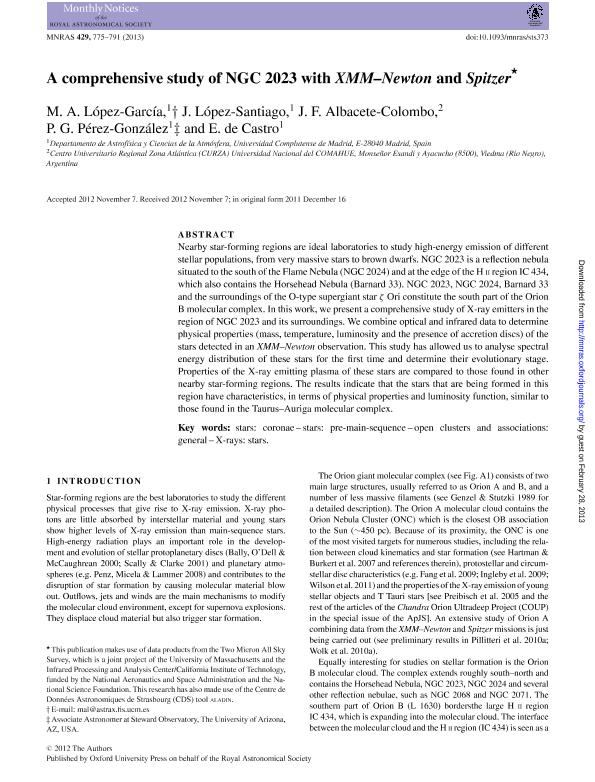Mostrar el registro sencillo del ítem
dc.contributor.author
López García, M. A.
dc.contributor.author
López Santiago, J.
dc.contributor.author
Albacete Colombo, Juan Facundo

dc.contributor.author
Pérez Gónzalez, P. G.
dc.contributor.author
de Castro, E.
dc.date.available
2017-01-10T18:38:14Z
dc.date.issued
2013-01
dc.identifier.citation
López García, M. A.; López Santiago, J.; Albacete Colombo, Juan Facundo; Pérez Gónzalez, P. G. ; de Castro, E.; A comprehensive study of NGC 2023 with XMM–Newton and Spitzer; Oxford University Press; Monthly Notices of the Royal Astronomical Society; 429; 1; 1-2013; 775-791
dc.identifier.issn
0035-8711
dc.identifier.uri
http://hdl.handle.net/11336/11040
dc.description.abstract
Nearby star-forming regions are ideal laboratories to study high-energy emission of different stellar populations, from very massive stars to brown dwarfs. NGC 2023 is a reflection nebula situated to the south of the Flame Nebula (NGC 2024) and at the edge of the H II region IC 434, which also contains the Horsehead Nebula (Barnard 33). NGC 2023, NGC 2024, Barnard 33 and the surroundings of the O-type supergiant star ζ Ori constitute the south part of the Orion B molecular complex. In this work, we present a comprehensive study of X-ray emitters in the region of NGC 2023 and its surroundings. We combine optical and infrared data to determine physical properties (mass, temperature, luminosity and the presence of accretion discs) of the stars detected in an XMM–Newton observation. This study has allowed us to analyse spectral energy distribution of these stars for the first time and determine their evolutionary stage. Properties of the X-ray emitting plasma of these stars are compared to those found in other nearby star-forming regions. The results indicate that the stars that are being formed in this region have characteristics, in terms of physical properties and luminosity function, similar to those found in the Taurus–Auriga molecular complex.
dc.format
application/pdf
dc.language.iso
eng
dc.publisher
Oxford University Press

dc.rights
info:eu-repo/semantics/openAccess
dc.rights.uri
https://creativecommons.org/licenses/by-nc-sa/2.5/ar/
dc.subject
Stars: Coronae
dc.subject
Stars: Pre-Main-Sequence
dc.subject
Open Clusters And Associations: General
dc.subject
X-Rays: Stars
dc.subject.classification
Astronomía

dc.subject.classification
Ciencias Físicas

dc.subject.classification
CIENCIAS NATURALES Y EXACTAS

dc.title
A comprehensive study of NGC 2023 with XMM–Newton and Spitzer
dc.type
info:eu-repo/semantics/article
dc.type
info:ar-repo/semantics/artículo
dc.type
info:eu-repo/semantics/publishedVersion
dc.date.updated
2017-01-06T20:02:13Z
dc.identifier.eissn
1365-2966
dc.journal.volume
429
dc.journal.number
1
dc.journal.pagination
775-791
dc.journal.pais
Reino Unido

dc.journal.ciudad
Londres
dc.description.fil
Fil: López García, M. A.. Universidad Complutense de Madrid; España
dc.description.fil
Fil: López Santiago, J.. Universidad Complutense de Madrid; España
dc.description.fil
Fil: Albacete Colombo, Juan Facundo. Consejo Nacional de Investigaciones Científicas y Técnicas; Argentina. Universidad Nacional del Comahue. Centro Universidad Región Zona Atlántica; Argentina
dc.description.fil
Fil: Pérez Gónzalez, P. G. . Universidad Complutense de Madrid; España
dc.description.fil
Fil: de Castro, E.. Universidad Complutense de Madrid; España
dc.journal.title
Monthly Notices of the Royal Astronomical Society

dc.relation.alternativeid
info:eu-repo/semantics/altIdentifier/url/http://mnras.oxfordjournals.org/content/429/1/775
dc.relation.alternativeid
info:eu-repo/semantics/altIdentifier/doi/http://dx.doi.org/10.1093/mnras/sts373
Archivos asociados
